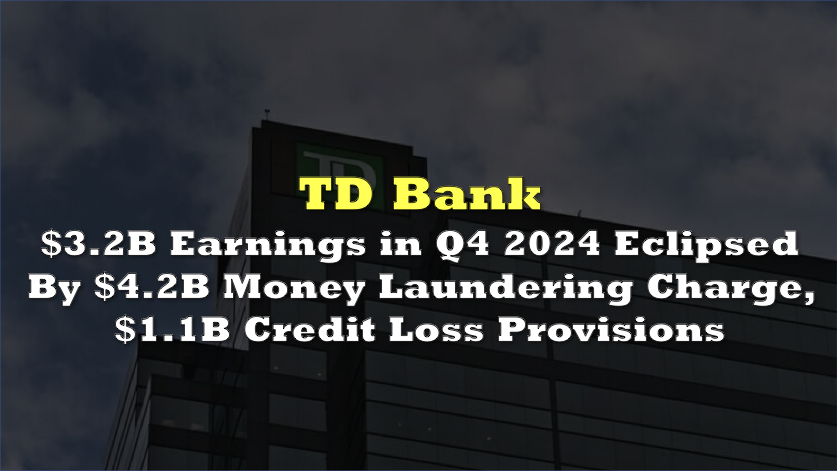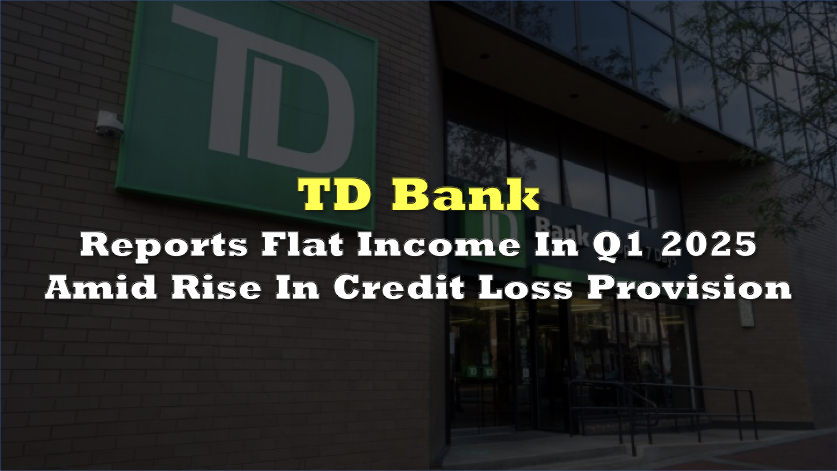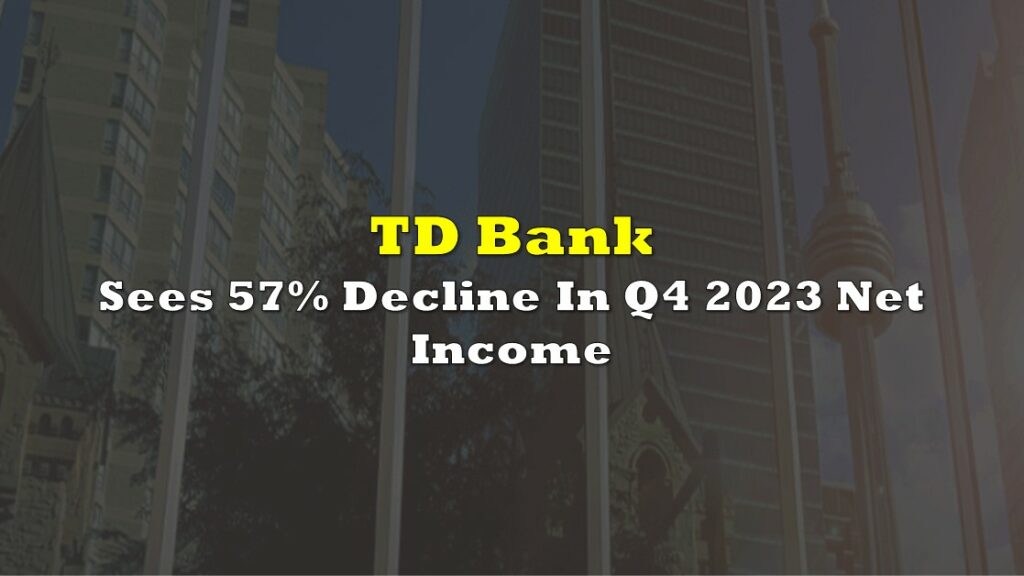TD Bank Group (TSX: TD) has reported mixed financial results for its fourth quarter and full fiscal year ending October 31, 2024. For the fourth quarter, TD reported net income of $3.6 billion, a substantial 26.8% increase compared to $2.9 billion in the same quarter last year.
However, the adjusted net income declined by 8% to $3.2 billion from $3.5 billion in the fourth quarter of 2023. This decline is particularly striking given the bank’s total revenue growth of 17.7% to $15.5 billion, compared to $13.2 billion a year earlier. On a sequential basis, the results also showed signs of strain, with adjusted net income down by 12% from $3.6 billion in the third quarter of 2024.
Earnings per share presented a similarly nuanced picture. Reported diluted EPS surged to $1.97 in the fourth quarter from $1.48 a year ago. Yet, adjusted diluted EPS fell to $1.72 from $1.82 year-over-year and dropped sharply from $2.05 in the prior quarter.
Provisions for credit losses rose to $1.1 billion in Q4 2024, compared to $878 million in the same quarter last year, and were slightly higher than the $1.07 billion reported in Q3. This increase underscores the deteriorating credit environment, as high interest rates and slowing economic growth put stress on borrowers.
Similarly, non-interest expenses ballooned to $8.05 billion in the quarter, up 5.5% year-over-year from $7.63 billion and 9.1% sequentially from $7.31 billion in Q3. While management attributed some of these costs to investments in infrastructure and risk controls, particularly in the U.S., the rising expense base weighed heavily on adjusted earnings.
Segment performance painted a mixed picture of TD’s operations. In its Canadian Personal and Commercial Banking division, net income grew 9% year-over-year to $1.82 billion, supported by a 7% increase in revenue to $5.06 billion. Provisions for credit losses in this segment jumped by 10.3% from Q4 2023, tempering the overall gains. Compared to the previous quarter, net income in this segment grew by a modest 3.2%.
In contrast, the U.S. Retail Banking segment’s reported net income for the quarter plummeted 32% year-over-year to $863 million and declined by 24.5% from $1.14 billion in Q3. Adjusted net income also declined sharply, falling 14% year-over-year and 11% sequentially due to higher PCLs and increased expenses. The investment in Charles Schwab (NYSE: SCHW) contributed $154 million in net income for the quarter, down 22% from the same period last year.
TD’s Wealth Management and Insurance segment also faced headwinds despite a 33% increase in revenue to $3.94 billion. Net income in the segment declined 29% year-over-year to $349 million, primarily due to significant claims costs arising from severe weather events in Calgary and Quebec. Sequentially, net income in the segment contracted by 13.2%.
Wholesale Banking delivered a more positive performance, with adjusted net income rising 68% year-over-year to $299 million. Revenue climbed 19% to $1.77 billion, bolstered by gains in lending, trading, and underwriting activities. On a sequential basis, adjusted net income in this segment grew by 12.8%.
For the full fiscal year, TD’s reported net income declined by 17% to $8.8 billion, down from $10.6 billion in 2023. Adjusted net income also fell, albeit more modestly, declining 4.8% to $14.3 billion from $15.0 billion last year. Revenue for the year grew to $57.2 billion, up 12.8% from $50.7 billion in fiscal 2023, but this increase was offset by rising expenses and a deteriorating credit environment.
The bank’s reported EPS for the year dropped to $4.72 from $5.52 in 2023, while adjusted EPS slipped slightly to $7.81 from $7.91. These figures reflect the impact of mounting costs, including a $4.2 billion charge related to the resolution of its U.S. anti-money laundering investigations.
TD’s Common Equity Tier 1 (CET1) capital ratio came out at 13.1%, a slight improvement from 12.8% in the previous quarter, though down from 14.4% a year earlier. Total deposits increased to $1.27 trillion, up from $1.2 trillion last year, while loans grew to $949.5 billion, compared to $895.9 billion in 2023.
Looking ahead, TD’s management acknowledged that fiscal 2025 will be a “transition year.” The bank has suspended its medium-term financial targets, including its goal of 7–10% adjusted EPS growth, citing the need to focus on remediation efforts, particularly in its U.S. operations. CEO Bharat Masrani emphasized that while the bank is well-positioned for long-term growth, the coming year will require disciplined capital allocation and enhanced operational efficiency to navigate ongoing challenges.
“A key development this quarter was the resolution of our U.S. AML matters, bringing important clarity to our stakeholders. Remediation is our number one priority, and we continue to make meaningful progress in addressing the failures,” Masrani said in a statement.
TD last traded at $79.66 on the TSX.
Information for this briefing was found via Sedar and the sources mentioned. The author has no securities or affiliations related to this organization. Not a recommendation to buy or sell. Always do additional research and consult a professional before purchasing a security. The author holds no licenses.









